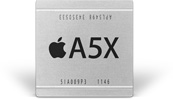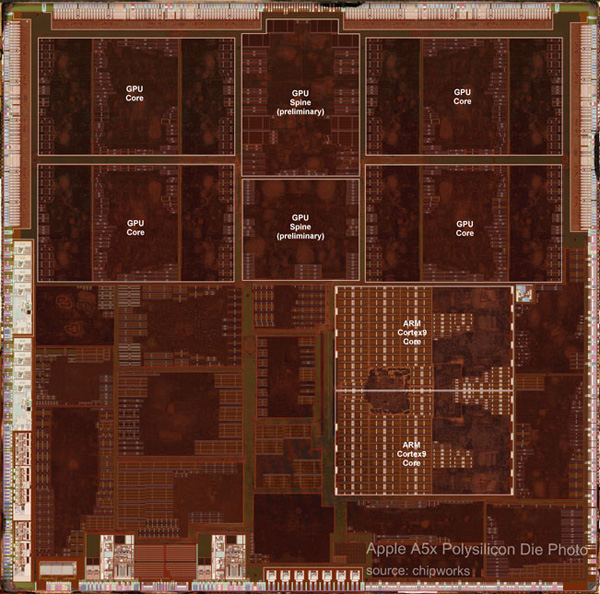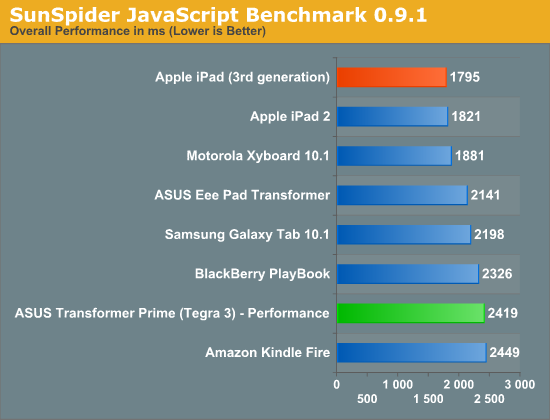The Apple iPad Review (2012)
by Vivek Gowri & Anand Lal Shimpi on March 28, 2012 3:14 PM ESTThe A5X SoC
The ridiculousness of the new iPad begins at its heart: the A5X SoC.

The A5X breaks Apple's longstanding tradition of debuting its next smartphone SoC in the iPad first. I say this with such certainty because the A5X is an absolute beast of an SoC. As it's implemented in the new iPad, the A5X under load consumes more power than an entire iPhone 4S.
In many ways in the A5X is a very conservative design, while in others it's absolutely pushing the limits of what had been previously done in a tablet. Similar to the A5 and A4 before it, the A5X is still built on Samsung's 45nm LP process. Speculation about a shift to 32nm or even a move TSMC was rampant this go around. I'll admit I even expected to see a move to 32nm for this chip, but Apple decided that 45nm was the way to go.
Why choose 45nm over smaller, cooler running options that are on the table today? Process maturity could be one reason. Samsung has yet to ship even its own SoC at 32nm, much less one for Apple. It's quite possible that Samsung's 32nm LP simply wasn't ready/mature enough for the sort of volumes Apple needed for an early 2012 iPad launch. The fact that there was no perceivable slip in the launch timeframe of the new iPad (roughly 12 months after its predecessor) does say something about how early 32nm readiness was communicated to Apple. Although speculation is quite rampant about Apple being upset enough with Samsung to want to leave for TSMC, the relationship on the foundry side appears to be good from a product delivery standpoint.
Another option would be that 32nm was ready but Apple simply opted against using it. Companies arrive at different conclusions as to how aggressive they need to be on the process technology side. For example, ATI/AMD was typically more aggressive on adopting new process technologies while NVIDIA preferred to make the transition once all of the kinks were worked out. It could be that Apple is taking a similar approach. Wafer costs generally go up at the start of a new process node, combine that with lower yields and strict design rules and it's not a guarantee that you'd actually save any money from moving to a new process technology—at least not easily or initially. The associated risk of something going wrong might have been one that Apple wasn't willing to accept.
| CPU Specification Comparison | ||||||||
| CPU | Manufacturing Process | Cores | Transistor Count | Die Size | ||||
| Apple A5X | 45nm | 2 | ? | 163mm2 | ||||
| Apple A5 | 45nm | 2 | ? | 122mm2 | ||||
| Intel Sandy Bridge 4C | 32nm | 4 | 995M | 216mm2 | ||||
| Intel Sandy Bridge 2C (GT1) | 32nm | 2 | 504M | 131mm2 | ||||
| Intel Sandy Bridge 2C (GT2) | 32nm | 2 | 624M | 149mm2 | ||||
| NVIDIA Tegra 3 | 40nm | 4+1 | ? | ~80mm2 | ||||
| NVIDIA Tegra 2 | 40nm | 2 | ? | 49mm2 | ||||
Whatever the reasoning, the outcome is significant: the A5X is approximately 2x the size of NVIDIA's Tegra 3, and even larger than a dual-core Sandy Bridge desktop CPU. Its floorplan is below:

Courtesy: Chipworks
From the perspective of the CPU, not much has changed with the A5X. Apple continues to use a pair of ARM Cortex A9 cores running at up to 1.0GHz, each with MPE/NEON support and a shared 1MB L2 cache. While it's technically possible for Apple to have ramped up CPU clocks in pursuit of higher performance (A9 designs have scaled up to 1.6GHz on 4x-nm processes), Apple has traditionally been very conservative on CPU clock frequency. Higher clocks require higher voltages (especially on the same process node), which result in an exponential increase in power consumption.
| ARM Cortex A9 Based SoC Comparison | ||||||
| Apple A5X | Apple A5 | TI OMAP 4 | NVIDIA Tegra 3 | |||
| Manufacturing Process | 45nm LP | 45nm LP | 45nm LP | 40nm LPG | ||
| Clock Speed | Up to 1GHz | Up to 1GHz | Up to 1GHz | Up to 1.5GHz | ||
| Core Count | 2 | 2 | 2 | 4+1 | ||
| L1 Cache Size | 32KB/32KB | 32KB/32KB | 32KB/32KB | 32KB/32KB | ||
| L2 Cache Size | 1MB | 1MB | 1MB | 1MB | ||
| Memory Interface to the CPU | Dual Channel LP-DDR2 | Dual Channel LP-DDR2 | Dual Channel LP-DDR2 | Single Channel LP-DDR2 | ||
| NEON Support | Yes | Yes | Yes | Yes | ||
With no change on the CPU side, CPU performance remains identical to the iPad 2. This means everything from web page loading to non-gaming app interactions are no faster than they were last year:


JavaScript performance remains unchanged, as you can see from both the BrowserMark and SunSpider results above. Despite the CPU clock disadvantage compared to the Tegra 3, Apple does have the advantage of an extremely efficient and optimized software stack in iOS. Safari just went through an update in improving its Javascript engine, which is why we see competitive performance here.
Geekbench has been updated with Android support, so we're able to do some cross platform comparisons here. Geekbench is a suite composed of completely synthetic, low-level tests—many of which can execute entirely out of the CPU's L1/L2 caches.
| Geekbench 2 | ||||||
| Apple iPad (3rd gen) | ASUS TF Prime | Apple iPad 2 | Motorola Xyboard 10.1 | |||
| Integer Score | 688 | 1231 | 684 | 883 | ||
| Blowfish ST | 13.2 MB/s | 23.3 MB/s | 13.2 MB/s | 17.6 MB/s | ||
| Blowfish MT | 26.3 MB/s | 60.4 MB/s | 26.0 MB/s | - | ||
| Text Compress ST | 1.52 MB/s | 1.58 MB/s | 1.51 MB/s | 1.63 MB/s | ||
| Text Compress MT | 2.85 MB/s | 3.30 MB/s | 2.83 MB/s | 2.93 MB/s | ||
| Text Decompress ST | 2.08 MB/s | 2.00 MB/s | 2.09 MB/s | 2.11MB/s | ||
| Text Decompress MT | 3.20 MB/s | 3.09 MB/s | 3.27 MB/s | 2.78 MB/s | ||
| Image Compress ST | 4.09 Mpixels/s | 5.56 Mpixels/s | 4.08 Mpixels/s | 5.42 Mpixels/s | ||
| Image Compress MT | 8.12 Mpixels/s | 21.4 Mpixels/s | 7.98 Mpixels/s | 10.5 Mpixels/s | ||
| Image Decompress ST | 6.70 Mpixels/s | 9.37 Mpixels/s | 6.67 Mpixels/s | 9.18 Mpixels/s | ||
| Image Decompress MT | 13.2 Mpixels/s | 20.3 Mpixels/s | 13.0 Mpixels/s | 17.9 Mpixels/s | ||
| Lua ST | 257.2 Knodes/s | 417.9 Knodes/s | 257.0 Knodes/s | 406.9 Knodes/s | ||
| Lua MT | 512.3 Knodes/s | 1500 Knodes/s | 505.6 Knodes/s | 810.0 Knodes/s | ||
| FP Score | 920 | 2223 | 915 | 1514 | ||
| Mandelbrot ST | 279.5 MFLOPS | 334.8 MFLOPS | 279.0 MFLOPS | 328.9 MFLOPS | ||
| Mandelbrot MT | 557.0 MFLOPS | 1290 MFLOPS | 550.3 MFLOPS | 648.0 MFLOPS | ||
| Dot Product ST | 221.9 MFLOPS | 477.5 MFLOPS | 221.5 MFLOPS | 455.2 MFLOPS | ||
| Dot Product MT | 438.9 MFLOPS | 1850 MFLOPS | 439.4 MFLOPS | 907.4 MFLOPS | ||
| LU Decomposition ST | 217.5 MFLOPS | 171.4 MFLOPS | 214.6 MFLOPS | 177.9 MFLOPS | ||
| LU Decomposition MT | 434.2 MFLOPS | 333.9 MFLOPS | 437.4 MFLOPS | 354.1 MFLOPS | ||
| Primality ST | 177.3 MFLOPS | 175.6 MFLOPS | 178.0 MFLOPS | 172.9 MFLOPS | ||
| Primality MT | 321.5 MFLOPS | 273.2 MFLOPS | 316.9 MFLOPS | 220.7 MFLOPS | ||
| Sharpen Image ST | 1.68 Mpixels/s | 3.87 Mpixels/s | 1.68 Mpixels/s | 3.86 Mpixels/s | ||
| Sharpen Image MT | 3.35 Mpixels/s | 9.85 Mpixels/s | 3.32 Mpixels/s | 7.52 Mpixels/s | ||
| Blur Image ST | 666.0 Kpixels/s | 1.62 Kpixels/s | 664.8 Kpixels/s | 1.58 Kpixels/s | ||
| Blur Image MT | 1.32 Mpixels/s | 6.25 Mpixels/s | 1.31 Mpixels/s | 3.06 Mpixels/s | ||
| Memory Score | 821 | 1079 | 829 | 1122 | ||
| Read Sequential ST | 312.0 MB/s | 249.0 MB/s | 347.1 MB/s | 364.1 MB/s | ||
| Write Sequential ST | 988.6 MB/s | 1.33 GB/s | 989.6 MB/s | 1.32 GB/s | ||
| Stdlib Allocate ST | 1.95 Mallocs/sec | 2.25 Mallocs/sec | 1.95 Mallocs/sec | 2.2 Mallocs/sec | ||
| Stdlib Write | 2.90 GB/s | 1.82 GB/s | 2.90 GB/s | 1.97 GB/s | ||
| Stdlib Copy | 554.6 MB/s | 1.82 GB/s | 564.5 MB/s | 1.91 GB/s | ||
| Stream Score | 331 | 288 | 335 | 318 | ||
| Stream Copy | 456.4 MB/s | 386.1 MB/s | 466.6 MB/s | 504 MB/s | ||
| Stream Scale | 380.2 MB/s | 351.9 MB/s | 371.1 MB/s | 478.5 MB/s | ||
| Stream Add | 608.8 MB/s | 446.8 MB/s | 654.0 MB/s | 420.1 MB/s | ||
| Stream Triad | 457.7 MB/s | 463.7 MB/s | 437.1 MB/s | 402.8 MB/s | ||
Almost entirely across the board NVIDIA delivers better CPU performance, either as a result of having more cores, having higher clocked cores or due to an inherent low-level Android advantage. Prioritizing GPU performance over a CPU upgrade is nothing new for Apple, and in the case of the A5X Apple could really only have one or the other—the new iPad gets hot enough and draws enough power as it is; Apple didn't need an even more power hungry set of CPU cores to make matters worse.
Despite the stagnation on the CPU side, most users would be hard pressed to call the iPad slow. Apple does a great job of prioritizing responsiveness of the UI thread, and all the entire iOS UI is GPU accelerated, resulting in a very smooth overall experience. There's definitely a need for faster CPUs to enable some more interesting applications and usage models. I suspect Apple will fulfill that need with the A6 in the 4th generation iPad next year. That being said, in most applications I don't believe the iPad feels slow today.
I mention most applications because there are some iOS apps that are already pushing the limits of what's possible today.
iPhoto: A Case Study in Why More CPU Performance is Important
In our section on iPhoto we mentioned just how frustratingly slow the app can be when attempting to use many of its editing tools. In profiling the app it becomes abundantly clear why it's slow. Despite iPhoto being largely visual, it's extremely CPU bound. For whatever reason, simply having iPhoto open is enough to eat up an entire CPU core.
Use virtually any of the editing tools and you'll see 50—95% utilization of the remaining, unused core. The screenshot below is what I saw during use of the saturation brush:

The problem is not only are the two A9s not fast enough to deal with the needs of iPhoto, but anything that needs to get done in the background while you're using iPhoto is going to suffer as well. This is most obvious when you look at how long it takes for UI elements within iPhoto to respond when you're editing. It's very rare that we see an application behave like this on iOS, even Infinity Blade only uses a single core most of the time, but iPhoto is a real exception.
I have to admit, I owe NVIDIA an apology here. While I still believe that quad-cores are mostly unnecessary for current smartphone/tablet workloads, iPhoto is a very tangible example of where Apple could have benefitted from having four CPU cores on A5X. Even an increase in CPU frequency would have helped. In this case, Apple had much bigger fish to fry: figuring out how to drive all 3.1M pixels on the Retina Display.










234 Comments
View All Comments
zanon - Wednesday, March 28, 2012 - link
In the article:The higher resolution does make smaller fonts readable. For something like an SSH session, that really will mean significantly more stuff can be on a screen at once.
MobiusStrip - Thursday, March 29, 2012 - link
A more useful change would be abandoning the ridiculous glossy screens. It's sad that Apple takes its cues from the plastic schlock being peddled at Best Buy, and participates in this fraud of shoving glossy screens down customers' throats.repoman27 - Thursday, March 29, 2012 - link
The plastic schlock at Best Buy has a glossy plastic film applied to a cheap TN panel. Apple puts a piece of glass in front of their much more expensive IPS panels to protect them. The only way to make that glass (or the glass of the LCD panel itself) matte would be to apply an antiglare plastic film coating to the glass. These films have drawbacks (they block and scatter light making small details and text blurry.) The drawbacks become more exaggerated the farther the front surface of the glass is from the plane of the actual LCD.But you're right, it's probably Apple copying the design language of sub $500 laptops in order to somehow defraud the general public and force their customers to buy the products they actually produce.
And seeing as how this discussion is about the new iPad screen, I'd like to point out that you're complaining about the lack of an antiglare coating on a touchscreen device... Strong work.
Sabresiberian - Thursday, March 29, 2012 - link
How is it fraud? Apple isn't, like, saying their screens are anti-reflective and then giving you totally reflective glossy screens.Many people prefer a glossy screen and simply aren't bothered by background reflections.
;)
Henk Poley - Monday, April 2, 2012 - link
Yes, Apple really should use Schott Conturan/Amiran/Mirogard antireflective technology.btw, not-glossy does not mean matte. Air is not matte either. Glass can be see-through too ;)
Watwatwat - Monday, April 2, 2012 - link
Nope, steve gibson has tested even using screen protectors on the new ipad vs not, it seems to affect the resolution at that level, matte might not be a good idea at all for high density display.KoolAidMan1 - Thursday, March 29, 2012 - link
I wasn't initially blown away, but then after a day of using it every other display seemed bad in comparison. It is one of those things you didn't realize was needed until using it, now I want very high DPI in all of my monitors.menting - Wednesday, March 28, 2012 - link
Is it just me, or do Shadowgun and GTA screenshots look more detailed in Transformer Prime than in the iPad?menting - Wednesday, March 28, 2012 - link
nm..i just noticed that it's scaled up in new ipad, so it's definitely not as sharp.However, how can fps be fairly compared in this case then?
TheJian - Wednesday, March 28, 2012 - link
Basically because of the way Nvidia and Apple approach games so far, you can expect games on Tegra3 to just look better as they seem to aim for more graphics and fewer games (they spend money on fewer projects that produce better results), as opposed to apple who spreads the wealth but just ends up with more cannon fodder if you ask me :) You should get more variety on Apple I'd guess, but a better experience with fewer choices on Tegra3/Android. I like QUALITY over QUANTITY personally and hope Apple leans the way of Nvidia in the future. I would rather have 10 games that I'd play for weeks or months (if I'm playing on my hdtv through one of these I want better water, buildings etc) rather than games I fire up for less than 20 minutes as their just another angry birds variant and arguably useless on your TV.I want these devices to KILL the consoles next year and make MS/Nintendo etc give it up in 2015 or whenever the next revs should come. I hope they just realize we won't buy them anymore. DirectX11 on my phone/tablet and probably standard 25x14 resolutions by then (won't all be retina by 2015?) make a console purchase STUPID. This could be the merging of console/pc we need since phones/tablets rev yearly like pc's instead of 10yr console's stuck in stone stagnating gaming. Your phone as a portable console with xbox/ps3/pc gamepad support would be excellent. Pump it out to a monitor and keyboard/mouse setup and you have a notebook replacement too...LOL Now if they'd just put in a few extra cores by then that will disable if on their own screen but turn on when on a larger display like TV/Monitor and we have exactly what we want in both cases :)
Pipe dreams? Retina is here now, and gamepads sort of. Next stop cores that only turn on depending on display output :) Awesome battery on the road, and great power in the dock at home pushing your 27in monitor. :) The 28nm versions by xmas of everyone's chips should come close to console power or surpass them. Interesting times.